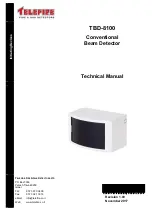
TBD-8100
© 2017
– Telefire Fire & Gas Detectors Ltd
Revision 1.00 November 2017
– Page 9 of 10 –
3.5
Testing the Detectors in the Field after Installation
i
Note
Ensure that the control panel is in walk test mode before testing the
detectors.
1. Execute the detector field-test:
2. Cover the prism with a non-transparent material (cardboard)
3. Ensure that the detector does not enter a fault status for a period of 5 seconds, and
after 20 seconds the control panel indicates a fault
4.
Verify that the detector’s red LED flashes every 1 second
5. Once the cardboard has been removed from the prism, verify, that the detector
returns to normal operation and the red LED flashes once every 5 seconds
6. Cover 70% of the prism, and induce an alarm
This action can also be carried out by bringing a magnet near the display LED in the
optional TBD-8100R module, provided the LED is connected to the detector
7. Ensure that the detector is programmed in the appropriate matrices as specified by
the planning consultant.
3.6
Troubleshooting
Fault
Possible cause
Action
The red LED flashes every
second.
The voltage supplied to the
detector is not in the
allowed range (8-28V).
Check and correct the
voltage feeding the
detector.
All green LEDs are flashing
(see Figure 2).
The signal emitted by the
transmitter is too strong
Attach the black round
patch (supplied with the
detector) to the transmitter.
The red LED is lit
continuously.
The transmitter does not
emit a signal.
Adjust the detector per
section 3.4
The green LEDs are not on. No power to the detector.
Check the voltage at points
1-2 (24Vdc) in the detector.






























